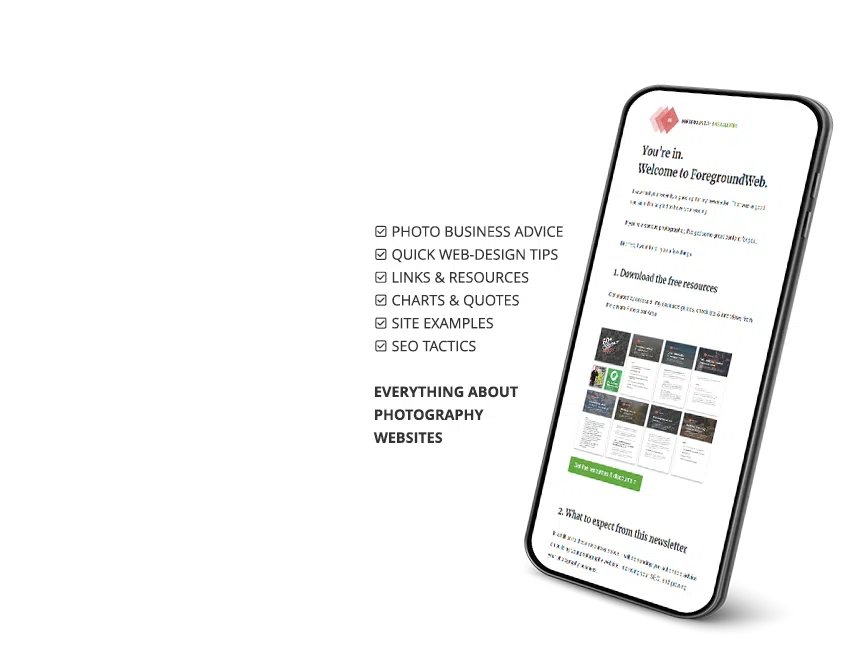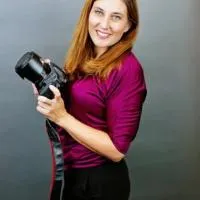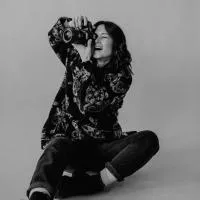Contents
Your photography website is the foreground of your business, it’s the first point of contact for fans or buyers. Even though every photographer envisions his/her website differently, some details should always be there.
Having worked with many photographers, I’ve noticed patterns in the way great websites are built and what contributes to their success (and try to always do the same in my work).
To help move you forward with your photography business goals and create an appealing website, I’ve compiled a list of 15 important photography ideas for your inspiration. They’re valid regardless of whether you’re just starting out as a photographer & looking for some guidance or simply need a photo website refresh.
1. Simplicity
Successful photographers have understood the value of simplicity, of focusing on the essentials and removing the superfluous. So even if you have a lot of content on your site, you should try to organize it in a simple way, to not confuse people and tempt them to leave the site.
Attaining a good level of simplicity (without sacrificing usability) is really tough!
Since many photographers struggle with this, I’ve tackled the topic separately in a detailed article here: Embracing minimalism in your photography website.
Simplicity helps you prioritize the important things, and it creates a better browsing experience for your users.
You have to learn how to thoughtfully limit your visitor’s choices and try to guide them through the site, to simplify your navigation & graphics, and to only emphasize the essential elements on the page.
Here’s an example of a simple & effective photo website:
 On Michael‘s website, nothing distracts your from the great intro images, there are no annoying splash pages, pop-ups, weird background colors, over-crowded elements or any “fluff” like that. You’re just getting a clear browsing experience: straightforward navigation and clear calls to action.
On Michael‘s website, nothing distracts your from the great intro images, there are no annoying splash pages, pop-ups, weird background colors, over-crowded elements or any “fluff” like that. You’re just getting a clear browsing experience: straightforward navigation and clear calls to action.
2. Clear navigation
Photographers are sometimes overly-concerned with the visual aspects of the site, at the expense of usability. 83% of visitors leave a website because it takes too many clicks to get to what they want, that’s a huge number!
Visitors should find it intuitive to navigate the site, so a few best practices are in order:
- keep the number of menu items to a minimum (up to 5 or 6 ideally)
- the menu should be placed either on the top or on the left side
- whatever the location, the menu should be in a consistent place throughout the site
- a quick way to get back to the homepage should always be present (usually through a “Home” menu item, or by clicking on the logo)
But it’s not just about the main menu. Any form of navigation needs to be thought of:
- clear calls-to-action (where should visitors on the page go to next?)
- quick navigation between images (left/right arrows and keyboard controls)
- easy browsing in and out of galleries
- quick access to contact information
- important areas in the site should be accessible in 2 clicks max

The “Search” page on “The Sartorialist” provides a wealth of searching and filtering options.
3. An effective Contact page
As I’ve already (and thoroughly) covered, easy access to your contact information is critical: The essentials of building an effective photography “Contact” page

If I were to choose just a couple of advice to share with all photographers out there, it would be to make your contact info as easily accessible as you can (including in the footer on every page), and to simplify the contact form as much as possible.
 The good: nice & clean design, contact numbers in the footer throughout the site, “Contact” last in the menu. The not-so-good: no email address, no “tel” links for phone numbers, too many (required) contact form fields, somewhat distracting slideshow.
The good: nice & clean design, contact numbers in the footer throughout the site, “Contact” last in the menu. The not-so-good: no email address, no “tel” links for phone numbers, too many (required) contact form fields, somewhat distracting slideshow.Read the entire article for an in-depth view of what you can do today to improve your photography Contact page (along with example/screenshots of how other photographers have done it well).
4. Blogging
A photography blog on your site gives you a great opportunity to continuously showcase your best work, to promote your services and/or to market your prints & products.
Blogs also have huge SEO benefits, but most importantly, they create a more personal connection with your audience. When you’re regularly publishing new articles and glimpses into your recent photography projects, visitors will trust your website more and keep coming back for updates. And Google will follow.
My blogging course for photographers is all you need to get you started blogging (covering topics like blog platforms, SEO tips, knowing what to blog about and how to promote and monetize your blog).
Learn how to start a successful blog
 Jasmine separated the blog area from her main site, but this way created a more creative blog with unique navigation.
Jasmine separated the blog area from her main site, but this way created a more creative blog with unique navigation. A more straightforward approach to blog page design, Burrard-Lucas has post excerpts on the left and useful widgets in the sidebar on the right.
A more straightforward approach to blog page design, Burrard-Lucas has post excerpts on the left and useful widgets in the sidebar on the right.
5. Using analytics
You can’t improve what you can’t measure!
There’s no top photographer out there who’s not using some analytics software to measure traffic to their website (with Google Analytics being the popular option of course).
But you need to take it one step further: it’s not just about getting traffic stats. You have to also interpret them and take informed decisions on how to improve things:
- Notice your bounce rate is too high? Try to add clear calls-to-action on main pages and make sure your navigation is easily accessible.
- See a traffic spike on certain days? Figure out where that traffic came from or try to replicate that type of content.
- Know people are doing image searches on your site? Track internal image searches to then add/promote more of the same.
- Want to optimize your site more? Try to learn more about your audience demographics to then better tailor your site content for them.
6. A great “About” page
Often being the second most visited page on a website, the Bio page is critical.
Successful photographers have learned to pay special attention to this page and have written their bio in a clear and concise way (along with a self-portrait of course, or a creative video with tools like Animoto).
Although simple at first sight, the process of writing something about yourself can be quite challenging, not to mention knowing what other elements to put on the page and how to optimize it.
Do yourself a favor and (re)read my Complete guide to building your amazing photography “About” page and get inspired by all the “About” page examples:
7. Bespoke design or a well-customized theme
Building a strong brand identity for your photography business requires something distinctive. In today’s flood of amateur websites, you have to make an effort to be unique.
This can be done by better understanding your audience and by catering your message to them. But it also has design implications. Regardless of your message, if visitors see your site and think “Blah, I’ve seen this before!”, that critical first impression is lost!
Going for a bespoke design from a quality designer can really set yourself from the pack. This is surely the most professional option. Based on your business goals, a “tailored” photography website can be much more effective than using existing themes/templates.

But even if you’re using a website theme to save some time or money, you should still put in some effort to personalize it as much as possible.
Don’t just add your logo and some images, look for things to make your site unique:
- explore different background colors
- look for new fonts to better suit your site’s (desired) mood
- get more creative on your About page
- make your blog posts more prominent
- take advantage of custom CSS (where available) to further tweak things around
- go into your theme’s settings panel and explore all the possible options there, don’t just always stick with the default values
I help photographers worldwide with professional design and development services, SEO, consultancy, etc. Visit the “Web-design” page for a list of all the web-design services, or contact me for a free quote.
8. Speed and reliability
A common problem photographers face is with the quality of their hosting provider. The website is either slow to load (even with many performance improvements) or has frequent server hiccups (preventing visitors from loading the site for a few minutes/hours).
If you’re using WordPress, I can strongly recommend WP Engine, I’ve had a great experience with them in the past.
Many successful photographers have understood that a fast and error-free website is important. That means working on site performance, investing in a quality hosting provider, checking and fixing any broken links, and regularly doing small experiments to further improve things.
Website performance tips and best practices have been covered well in my 60+ Photography Website Mistakes guide:
“Visitors running into slow pages or broken functionality immediately lose trust and patience. You don’t want to look like you don’t care.“
9. Great SEO
Successful website owners pay attention to both on-site and off-site SEO.
The on-site info (title and meta description tags, headers, image captions and keywords, etc.) needs to be in a perfect state, so that Google can then properly index the site and attribute value to its rankings based on the specific content/keywords on the page.
Off-site SEO is more of a long-term strategy, mostly involving getting other sites to link back to you site (with good “anchor texts” if possible). If you haven’t embarked on a strategy to create backlinks (e.g. linking to your site from social media and community profiles, blogging about your website, getting other people to blog about you etc), then you won’t have much success with search engines, and therefore you won’t have many visitors.
You should think of each link as an endorsement of your content. The more links, the more the search engines are likely to consider you a credible search result.
All you need to know is here:
10. Infused with personality
Differentiating yourself through SEO tactics alone is nearly impossible. In this day and age, trust is the name of the game.
Using natural language and showing glimpses into your life are great ways to add personality to your website. Your photography About page is obviously a great opportunity to be creative (see notes above on “About pages”).
This feels like a great time to introduce you to my favorite quote (strangely enough, from singer and actress Dolly Parton):
“Find out who you are, and do it on purpose!” (Dolly Parton)
But showing your personality on a site can be very difficult when you’re trying to follow various rules/guidelines. You’re reading a lot of things like “you should do this…, you should do that…”, so you might feel you’re working within narrow margins and don’t have room to really express yourself.
I totally get that, I’ve felt overwhelmed like that many times in my career (both as a designer/developer, and also when starting in photography).
Awareness is important: the goal is not to follow some rules blindly, but to understand and selectively apply them while still being yourself!
 Is this a travel photography website or what? :-)
Is this a travel photography website or what? :-)
11. Focusing on quality over quantity
Successful photographers are bringing forward only their best work. When visitors reach your site, you only have a first impression, so make it count.
Filling entire pages with countless galleries and images won’t get you very far. (Some exceptions are worth mentioning here: stock photography archives, client/commissioned galleries, archive/backup folders.)
Content curation is a skill you really need to master if you want to reach an elite level. That means learning to let go of your mediocre content, and just sticking with your absolute best images (even if you think they’re too few to matter).
You should edit down as much as possible, and only promote the things you’re proud of. Don’t fill in gaps (with “average” content) just for the sake of it. So be conscious about the number of images in your slideshows or the number of featured galleries on your homepage, and only promote your best work.
Oh, and don’t forget that the order in which you sort images (in slideshows or portfolios) can also impact the way they’re perceived.
 Jimmy builds each portfolio/gallery with a reasonably small selection of his top images.
Jimmy builds each portfolio/gallery with a reasonably small selection of his top images. Richard carefully displays just a small selection of his best images.
Richard carefully displays just a small selection of his best images.
12. Freshness & consistency
Top photographers regularly keep adding quality content (images, articles) to the site because they’re successful and they have the time/money/connections/opportunities to do so. But the reverse is also true: they’re successful because they consistently keep adding content.
 Trey reached such an impressive social media following (8 million followers on Google+ alone) by consistently adding quality content to the blog.
Trey reached such an impressive social media following (8 million followers on Google+ alone) by consistently adding quality content to the blog.
But consistency is hard to achieve, so many photographers quit too early…
Even if you feel your work is not good enough, even if your blog posts aren’t too long, even if you feel it’s not worth it anymore, keep pushing through. When you’re down, what you’re feeling is inner resistance or a fear of failure. Learning to push past them can do wonders for your self-confidence and the quality of your work.
And even if you don’t have any recent new content (maybe you haven’t done a photo project in a while), at least go ahead and rotate some of your homepage content, change things up, make it look fresh. There’s nothing wrong with re-promoting some of your past content from time to time. More on this topic here: “Keeping your online portfolio fresh”
13. Mobile-friendly (responsive) design
Mobile browsing is huge these days, you can’t ignore it any longer. In fact, mobile-friendliness is now an important ranking factor for Google.
That means not forcing mobile users to pinch-and-zoom in order to navigate through your site. And that’s where responsive design comes into action, allowing your site’s content to properly adapt to any screen size, creating a much better browsing experience.
For photography website, this plays an even bigger role because users need to interact with the site more (to change slideshow images, to purchase images etc.) Great websites handle that well, resizing images/content as needed.
And speaking of modern mobile devices, serving high-quality (“retina”) images is also slowly becoming the norm.
You should definitely make sure your website is responsive, you can’t afford to alienate a good chunk of your visitors.
14. Social networking
Ever seen a top photographer not leveraging social media sites to expand his/her empire?
First of all, let’s make the distinction between share/like buttons and profile links. Everybody has share buttons (to act as “social proof” and/or to allow visitors to share the site on their own profiles).
Profiles links point instead to your own social media profiles. These act like “outposts”, outside of your site, helping you spread the message out into the online world.
All successful photographers have surely found this to be very powerful, and are investing their time and energy (and sometimes even money for advertising) into growing their social media followers.
This is a whole new ball game, and requires a lot of work. The “Photographer’s Social Media Handbook” is a great place to get you started.
 Trey Ratcliff is doing pretty well on Twitter, but nothing compared to his 8 million followers on Google Plus. Yes, 8 million!
Trey Ratcliff is doing pretty well on Twitter, but nothing compared to his 8 million followers on Google Plus. Yes, 8 million! Facebook is still the best way to help spread your content, and many top photographers are properly using it.
Facebook is still the best way to help spread your content, and many top photographers are properly using it.
15. Email newsletter
Almost all influential photographers leverage email marketing, it’s one of the best ways to build trust and deliver content to their fans.
But this is harder to grow than a social media following, because it requires adding frequent posts and regularly providing value to your subscribers. And even though the number of subscribers you have is much lower than your Facebook likes or Twitter followers, the “audience” is a lot more targeted: they are people who chose to subscribe, so they like your work and want to see more of it.
Besides broadcasting your blog posts to the email newsletter, you can also use it to promote your new services/products or to ask questions from your audience. It can be a great way to turn regular readers into potential customers.
I’m personally using MailChimp, it’s probably the most powerful and well-designed email newsletter service out there, and it’s available for free (up to 2000 subscribers, but still cheap afterward). MailChimp generates the newsletter subscribe box embed code to put on your site, it’s really simple to set up. If you’re just starting out with this, learn some best practices and be sure to include unsubscribe links to your email campaigns (so your emails will end up in spam folders).
If you look more closely, almost all of the websites mentioned above offer an email newsletter:
 Ken’s site displays a subscribe bar at the top (after scrolling through the page)
Ken’s site displays a subscribe bar at the top (after scrolling through the page)
Bonus
More reading & inspiration for your photography site
- The secrets to growing your photography business (besides building an amazing website): time, perseverance, desire to grow, and flexibility: The Secret to Creating a Successful Photography Business
- A nice article on how building an online business is a journey more than a destination: Three Traits of Successful Websites
- Great post about what it takes to build a successful brand: The Top 7 Characteristics Of Successful Brands
- The why and how of photography blogging: The Secrets of Successful Photography Blogging: How To Make It Worth Your Time
Conclusion
These are some of the most important attributes of successful photography websites. Trying to follow their lead and to reach the same level of website design quality, will surely raise your business to the next level.
But don’t forget that the photographers (behind these successful websites) also got there through hard work, through a continuous effort to go out there and take great images. Always keep focusing on the right things: images matter most.
How can YOU start making your photography website more successful?






















